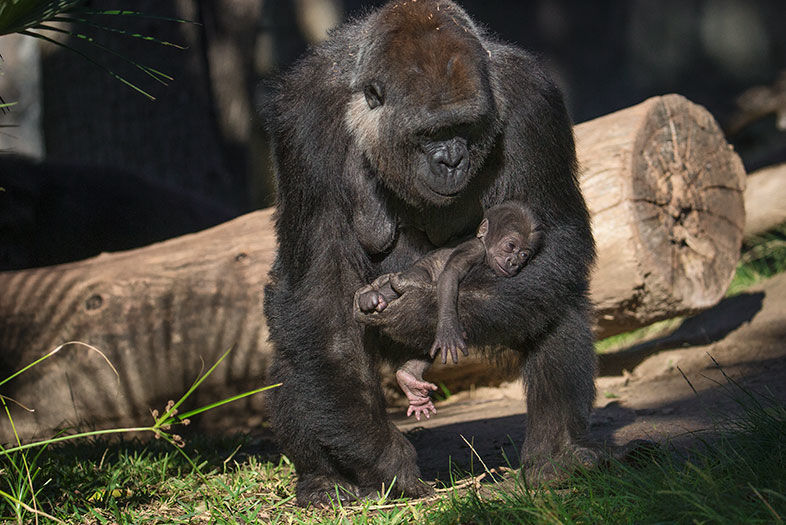In early January 2015, Dr. Jessica Kingston was called into surgery. A 34-year-old mother that had recently given birth was in trouble. The UC San Diego OB/GYN needed to examine the patient and, if necessary, remove any excess tissue from her uterus to stop her bleeding. She’d done this procedure at least a thousand times over the course of her career, so it was a routine operation on an otherwise routine day—with one major exception.
The patient was a gorilla.
The Western lowland gorilla, who coincidentally is also named Jessica, lives at the San Diego Zoo. Her sixth baby, a boy named Denny, was about a week old when keepers noticed drops of blood around her enclosure.
“After doing a visual exam and talking to my mentors, we decided to reach out to the medical team from UCSD,” says Dr. Katie Delk, a veterinarian currently in her third year of residency at the San Diego Zoo Safari Park. “We knew that the amount of bleeding was potentially serious, and we anticipated that the bleeding was coming from her reproductive tract, so we wanted to have reproductive specialists on hand.”
Kingston was game. “I thought it would be interesting,” she says. “The anatomy is pretty similar but not exact. It was great to use our experience taking care of humans to take care of a large primate. It makes a lot of sense.”
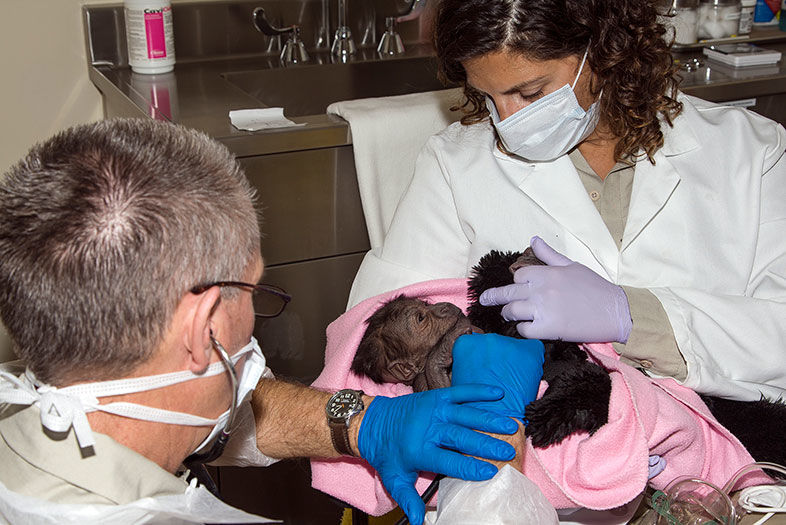
Animal Instinct: Saving Lives at the Zoo
Zookeeper Jennifer Minichino and veterinarian Dr. Jack Allen examine baby Joanne, born via emergency C-section at the san diego zoo safari park with the help of UCSD physicians. | Photo by tammy spratt, san diego zoo safari park
Zookeeper Jennifer Minichino and veterinarian Dr. Jack Allen examine baby Joanne, born via emergency C-section at the san diego zoo safari park with the help of UCSD physicians. | Photo by tammy spratt, san diego zoo safari park
But the prospect of examining or performing any kind of procedure on Jessica would be no small feat. In order to get close to a large animal like a gorilla, the animal must first be sedated. Then comes the exam, testing, blood work, ultrasounds or other imaging, surgery, and post-op care. What would ordinarily take place over multiple doctor visits in the human world takes place all in one day at the zoo. A crew of physicians in a variety of specialties must assemble beforehand and be at the ready.
“It takes a lot of coordination to get a team in place,” Kingston says, noting that the zoo’s resources are superior, but skills like hers are needed when special cases arise. “They [the veterinarians] have to know so much about so many different species that they never get to that [specialist] point in their careers. It was a great example of teamwork.”
This synchronized collaboration is just one piece of a little-known, unofficial partnership that’s been going on for decades, saving the lives of countless animals in the process.
Anesthesiologist Mark Greenberg has been working with the zoo for 21 years.
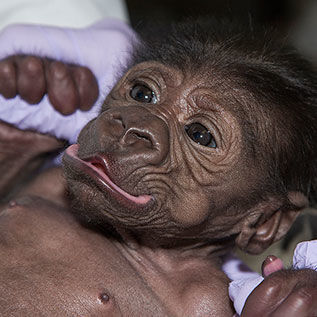
Animal Instinct: Saving Lives at the Zoo
After a few weeks of constant care, Joanne made a full recovery and was ready to be reintroduced to her mother.
“It started with Karen the orangutan,” recalls Greenberg, referring to an open-heart surgery performed by UCSD cardiothoracic surgeon Dr. Stuart Jamieson on a two-year-old Sumatran ape in 1994. But the relationship between the two organizations extends even farther back to the 1970s, when UCSD pathologist Dr. Kurt Benirschke convinced zoo trustees to start a research department. He led the department for years, and provided the link with UCSD that would ultimately save Karen’s life.
Dr. Don Janssen was there that day. “It was a transformative moment,” says Janssen, a veterinarian and the zoo’s director of animal health. “The takeaway for me was that, given enough effort with people who care, and combining expertise, you can do amazing things that you never thought were possible.”
Karen’s post-op care lasted for weeks and took the combined efforts of more than 100 volunteers to eventually nurse the young orangutan back to life. “That’s where the magic from UCSD happened,” Janssen says. “To get that animal through that stage of critical care took a lot of help and coordination.”
Greenberg was the UC doctor that organized Karen’s post-op care. From then on, he was hooked, and has since “given anesthesia for just about every species,” including the zoo’s beloved giant pandas. Last year, he had a full-circle moment with another gorilla, Imani. After a prolonged labor and emergency C-section, Imani gave birth to a baby girl named Joanne. The baby suffered from pneumonia and a collapsed lung. Greenberg helped nurse her back to health. Two decades earlier, he had helped save Imani’s life when she was born prematurely.
“Imani’s mom couldn’t care for her, so we hand-raised her,” he remembers. “Twenty years later we did her C-section and cared for her baby. We were able to reintroduce the two, and she raised baby Joanne, who is now over 15 months old.”
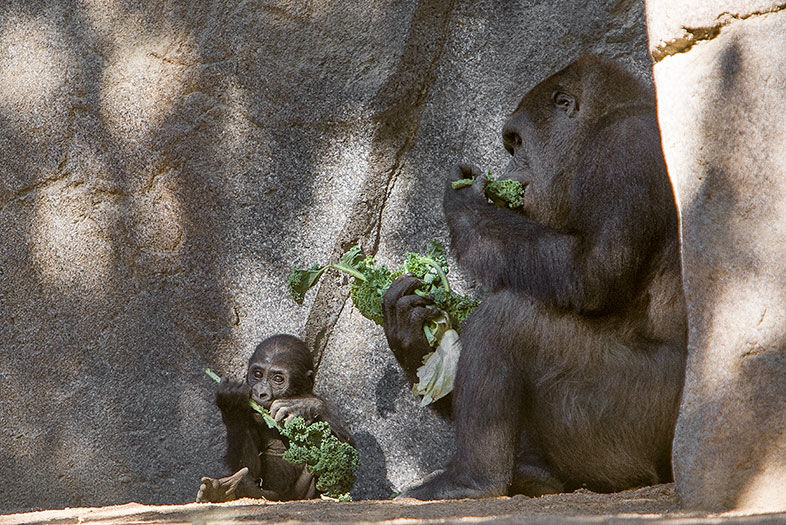
Animal Instinct: Saving Lives at the Zoo
Imani and baby Joanne share some kale at the San Diego Zoo Safari Park. Twenty years ago, UCSD doctors helped save Imani’s life when she was born prematurely. Last year, they helped save her baby.
Imani and baby Joanne share some kale at the San Diego Zoo Safari Park. Twenty years ago, UCSD doctors helped save Imani’s life when she was born prematurely. Last year, they helped save her baby.
“We appreciate evolution, but it was amazing to see that up close,” says Kingston, who was fascinated by Jessica the gorilla’s ability to breastfeed. With the help of zoo staffers who put the baby on her breast, the mother continued to nurse almost every hour while under anesthesia.
For a teaching institution like UCSD, this partnership is educational, a chance to expand its physicians’ knowledge and expertise. For the zoo, the partnership saves lives, and potentially more. The International Union for Conservation of Nature and Natural Resources considers gorillas critically endangered, so every life saved helps preserve the species.
Janssen says the doctors at UCSD and other medical consultants “extend our ability to provide medical care at the highest level. It gives our animals an opportunity to thrive. It certainly did for Karen.”
Karen the orangutan is alive and well at the zoo today; so are Jessica the gorilla and her baby boy Denny, Imani and baby Joanne, and countless other animals whom visitors have walked past and admired from afar, never knowing their stories, nor the medical miracles it took to get them there.
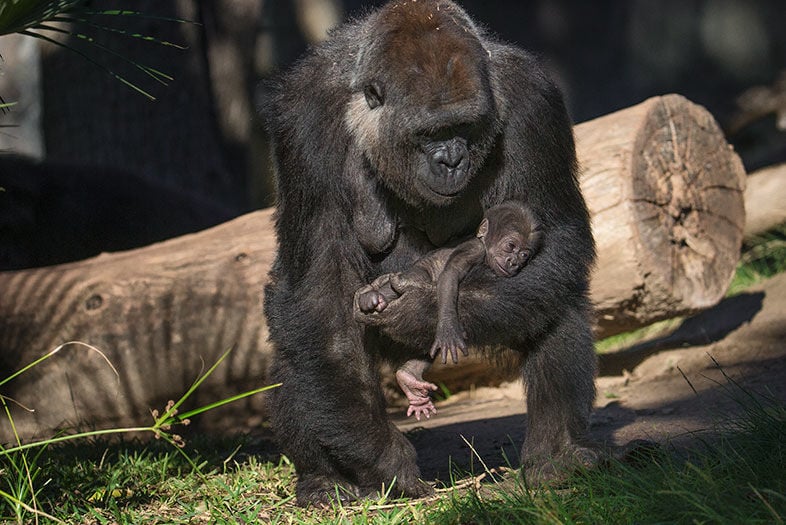
Animal Instinct: Saving Lives at the Zoo
PARTNER CONTENT
Jessica, a Western lowland gorilla at the San Diego Zoo, takes a stroll with her three-week-old baby. Doctors from UC San Diego Medical Center worked with zoo staffers to treat the mama gorilla following postpartum complications. | Photo by Ken Bohn, San Diego Zoo














